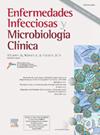qSOFA、NEWS 和 GYM 量表对急诊科感染老年患者死亡率的预测作用:EDEN-5 研究。
IF 2.5
4区 医学
Q3 INFECTIOUS DISEASES
Enfermedades infecciosas y microbiologia clinica
Pub Date : 2024-11-01
DOI:10.1016/j.eimc.2023.07.004
引用次数: 0
摘要
目的 分析医院急诊科(ED)在评估因感染性疾病就诊的老年患者时使用的NEWS、qSOFA和GYM评分的预后准确性。方法 使用EDEN(急诊科和老年人需求)队列的数据。该回顾性队列包括两周内(2019 年 1 月 4 日至 2019 年 4 月 7 日和 2020 年 3 月 30 日至 2020 年 4 月 5 日)在西班牙 52 家急诊室就诊的所有年龄≥ 65 岁、在急诊室诊断为传染病的患者。记录了人口统计学变量、合并症、查尔森和巴特尔指数以及所需评分参数。通过计算接收者操作特征曲线(ROC)下的面积来估计每种量表对 30 天死亡率的预测能力,并计算不同截断点的敏感性和特异性。主要结果变量为 30 天死亡率。中位年龄为 80 岁(IQR 73-87),女性占 45.3%。有 993 名患者(16.4%)死亡。NEWS 评分的 AUC 优于 qSOFA(0.765;95% CI:0.725-0.806,vs. 0.700;95% CI:0.653-0.746;P <;.001)和 GYM(0.716;95% CI:0.675-0.758;P = .024),而 qSOFA 和 GYM 之间没有差异(P = .345)。对 30 天死亡率敏感度最高的是 GYM ≥ 1 分(85.4%),而 qSOFA ≥ 2 分则显示出较高的特异性。NEWS评分对30天死亡率的预测能力最高。GYM 评分≥ 1 显示出很高的灵敏度,而 qSOFA 评分≥ 2 显示出最高的特异性,但灵敏度较低。本文章由计算机程序翻译,如有差异,请以英文原文为准。
Utilidad predictiva de mortalidad de las escalas qSOFA, NEWS y GYM en el paciente anciano con infección en urgencias: estudio EDEN-5
Objective
To analyze the prognostic accuracy of the scores NEWS, qSOFA, GYM used in hospital emergency department (ED) in the assessment of elderly patients who consult for an infectious disease.
Methods
Data from the EDEN (Emergency Department and Elderly Needs) cohort were used. This retrospective cohort included all patients aged ≥ 65 years seen in 52 Spanish EDs during two weeks (from 1/4/2019 to 7/4/2019 and 30/3/2020 to 5/4/2020) with an infectious disease diagnosis in the emergency department. Demographic variables, comorbidities, Charlson and Barthel index and needed scores parameters were recorded. The predictive capacity for 30-day mortality of each scale was estimated by calculating the area under the receiver operating characteristic (ROC) curve, and sensitivity and specificity were calculated for different cut-off points. The primary outcome variable was 30-day mortality.
Results
Six thousand fifty-four patients were analyzed. Median age was 80 years (IQR 73-87) and 45.3% women. Nine hundred and ninety-three (16.4%) patients died. NEWS score had better AUC than qSOFA (0.765; 95% CI: 0.725-0.806, vs. 0.700; 95% CI: 0.653-0.746; P < .001) and GYM (0.716; 95% CI: 0.675-0.758; P = .024), and there was no difference between qSOFA and GYM (P = .345). The highest sensitivity scores for 30-day mortality were GYM ≥ 1 point (85.4%) while the qSOFA score ≥ 2 points showed high specificity. In the case of the NEWS scale, the cut-off point ≥ 4 showed high sensitivity, while the cut-off point NEWS ≥ 8 showed high specificity.
Conclusion
NEWS score showed the highest predictive capacity for 30-day mortality. GYM score ≥ 1 showed a great sensitivity, while qSOFA ≥ 2 scores provide the highest specificity but lower sensitivity.
求助全文
通过发布文献求助,成功后即可免费获取论文全文。
去求助
来源期刊
CiteScore
2.10
自引率
8.00%
发文量
194
审稿时长
29 days
期刊介绍:
Hoy está universalmente reconocida la renovada y creciente importancia de la patología infecciosa: aparición de nuevos agentes patógenos, de cepas resistentes, de procesos con expresión clínica hasta ahora desconocida, de cuadros de una gran complejidad. Paralelamente, la Microbiología y la Infectología Clínicas han experimentado un gran desarrollo como respuesta al reto planteado por la actual patología infecciosa. Enfermedades Infecciosas y Microbiología Clínica es la Publicación Oficial de la Sociedad Española SEIMC. Cumple con la garantía científica de esta Sociedad, la doble función de difundir trabajos de investigación, tanto clínicos como microbiológicos, referidos a la patología infecciosa, y contribuye a la formación continuada de los interesados en aquella patología mediante artículos orientados a ese fin y elaborados por autores de la mayor calificación invitados por la revista.

 求助内容:
求助内容: 应助结果提醒方式:
应助结果提醒方式:


